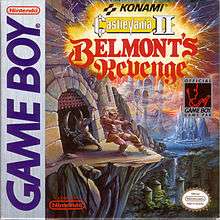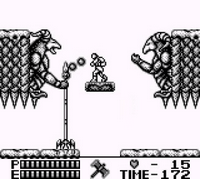Castlevania II: Belmont's Revenge
- Not to be confused with Castlevania II: Simon's Quest.
| Castlevania II: Belmont's Revenge | |
|---|---|
 North American box art | |
| Developer(s) | Konami |
| Publisher(s) | Konami |
| Programmer(s) |
Toru Hagihara Yukari Hayano |
| Artist(s) | Koichi Kimura |
| Composer(s) | Hidehiro Funauchi |
| Series | Castlevania |
| Platform(s) | Game Boy |
| Release date(s) |
Game Boy Game Boy Color
|
| Genre(s) | Platforming |
| Mode(s) | Single-player |
Castlevania II: Belmont's Revenge, known as Dracula Densetsu II (ドラキュラ伝説II, officially translated The Legend of Dracula II)[1] in Japan, is a platform game released for the Game Boy in 1991. It is the second Castlevania title for the Game Boy and serves as a sequel to the previous title, Castlevania: The Adventure. Belmont's Revenge is included in color in the fourth volume of the Konami GB Collection compilations.[2] Set fifteen years after the events of Castlevania: The Adventure, Dracula returns and kidnaps Christopher Belmont's son Soleiyu at his coming of age feast, and turns him into a demon. With Soleiyu's mystical powers, Dracula retakes human form and rebuilds his castle, forcing Christopher to confront Dracula once again to save his son and Transylvania.[3][4]
Gameplay

Unlike the previous Game Boy title, sub-weapons in the form of holy water and axes (or the cross in the Japanese version) are available in the game. There are four initial levels, each taking place in a separate castle with unique theme such as air, plant, earth, and crystal, and can be completed in any order.[3][5] There are also very large trap rooms in the levels.[3] The game also utilizes a password system.[4]
Development
The Japanese and Konami GB Collection version of the game changes one of the sub-weapons, replacing the axe with a cross.[5] While the axe can go in an upward arcing motion that can go through walls and barriers, the cross can do a back-and-forth horizontal motion.
The packaging artwork for the North American and European versions was created by Tom Dubois, who also designed the packaging for many other Konami titles outside Japan.[6]
Reception
IGN thought the game made better use of the Game Boy's hardware than the first Castlevania handheld, and also applauded its inclusion of traditional Castlevania items, weapons, and having a cleaner graphical aesthetic. It was still hurt, however, by a lack of character speed and its short play time.[3] GameSpy called it one of the best action games on the original Game Boy.[5] Game Informer's Tim Turi considers it the best Castlevania game on the original Game Boy; he cited the improved graphics and use of sub-weapons.[7]
References
- ↑ Perfect Selection Dracula ~New Classic~ (Media notes). King Records Co., Ltd. 1992.
- ↑ "Moby Games – Castlevania II: Belmont's Revenge". MobyGames. Retrieved August 18, 2016.
- 1 2 3 4 Mark Bozon (2007-01-18). "Castlevania: The Retrospective". IGN. Retrieved 2008-07-12.
- 1 2 Konami staff, ed. (1991). Castlevania II: Belmont's Revenge instruction manual. Konami. p. 11. ???-CW-USA.
- 1 2 3 "Castlevania 2: Belmont's Revenge (1991)". GameSpy. 1999-01-01. Retrieved 2008-07-13.
- ↑ Gidney, Adam. "Tom Dubois artist page". BOX=ART. Retrieved August 18, 2016.
- ↑ Turi, Tim (2012-04-04). "Ranking The Castlevania Bloodline". Game Informer. Retrieved 2013-12-05.